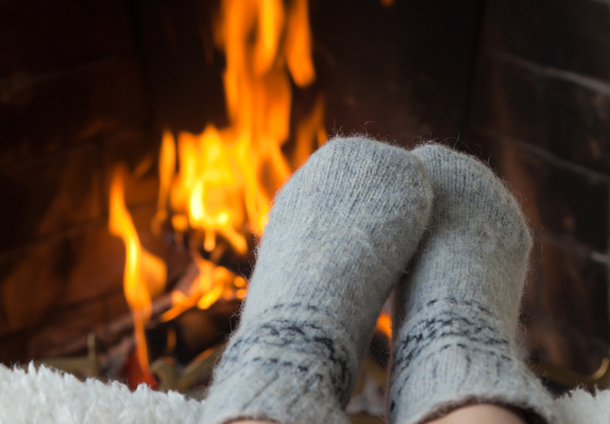
Winters can be wicked, with wind puffs belting down everywhere. It may make you think that your feet are fit and fine as long as you keep your shoes or boots on. With all the cold weather now here, there is no surprise that the number of patients complaining of winter foot problems will be soaring high. The cold weather induces the muscles, tendons and ligaments of the feet to become tighter than ever, hence making your feet more prone to aches, pains and possible injuries too. People who have continuous circulation troubles or work outdoors or wear tight constringed shoes are the most susceptible to this obnoxious weather. A large number of people suffer from chilblains, which primarily affects the toes and usually appear as small red itchy blobs. This is an abnormal reaction to the cold whereby the circulation is slow to respond to the warming of the toes. Preparations that contain calamine can be useful in symptom relief. You might be enticed to come in from the cold and put your feet next to a heat source such as a radiator or fire that actually causes chilblains or even make them worse. It is always the exposure to extreme heat or cold that causes the problem in the first place. A second condition affecting the feet due to sensitivity to the cold is Raynaud’s phenomenon. Here, the fine blood vessels in the toes restrict circulation by going into a spasm. The toes will feel cold and numb and change colour from blue to red. Let’s quickly go through some tips and tricks to avoid winter foot problems:
Avoid rapid change in temperature – Your body is unable to adapt to changes in temperature outside at the average pace. Normally, on heating, blood flow increases with dilatation of blood vessels and on cold stimulus, the blood flow decreases with narrowing of vessels. In your case on heating, the blood flow increases, but blood vessels fail to dilate to accommodate increase blood flow termed as “bottleneck effect”. The excess blood seeps out of capillaries leading to swelling and itching. Avoid rapid heating by exposing your itchy toes to a strong heat source.
Protect hands and feet from trauma and dryness – Dryness provokes chilblains and the right moisturiser provides insulation apart from preventing heat loss. Therefore never forget to put thick moisturiser several times in a day. You can also keep a petroleum jelly, coconut oil or any other sort of thick cream always handy and apply it each time you feel dryness or stretch in your hands or feet. Secondly, avoid trauma by avoiding tight or loose fitting shoes.
Dry Skin Risks Calluses and Cracks – Cold air does not hold much humidity, and therefore winter air tends to dry out your skin. In addition the extra hours spent in buildings with forced air heating, the problem gets coupled. Dry skin leads to built-up layers of calluses. Further the skin could then split, bleed, and form painful fissures which open feet to bacteria. Foot infections are an alarming risk if you are diabetic and poor circulation slows your healing time.
Keep your body warm – Wearing those gloves and socks are of least help unless your core body temperature is warm too. Remember to wear clothes that warm you up, eat warm meals, you can also add some of those extra spices such as black pepper, ginger, etc. in your meals. Warm teas made using herbs are of some help too. These help in warming up your body and improve circulation. Avoid cold drinks and cold and raw food like salads.
Improve your blood circulation – Causes of most foot problems is stagnant blood flow. You should exercise regularly or get yourself engaged in various physical activities to improve the blood circulation. Quitting smoking and alcohol will further impede blood flow.
Dirty Feet are Invitations to Infection – Although walking barefoot doesn’t pick up as much dust and grit, but that does not all mean that your feet isn’t clean. Bacteria and fungi enjoy nestling on unwashed skin and set up housekeeping. Combining that extra moisture of sweaty feet constringed in shoes all day create the perfect environment for fungal infection and smelly feet as well.
Sweaty Feet Make You Colder – Although it may seem capricious, but the truth is that you have more problem with foot perspiration in the winter than in the summer. This happens because of wearing covered shoes or waterproof boots when it is snowy and cold. Wearing with socks made of cotton or the wrong synthetics also trap moisture against the foot skin keeping feet constantly damp. Damp feet make you feel more colder and could possibly lead to hypothermia and frostbite too in bitterly cold temps.
Right Footwear Helps Being Safe – Shoes and boots designed for the right conditions are encountering. Deep snow means you need waterproof boots with higher tops to keep the snow out of them. On the other hand, icy conditions require good traction that slip on your footwear to help you grip the walkways.
Consult Doctor – Consulting a doctor is always required and needed if the foot problems get worse despite taking the right above measure. Visit a doctor if you develop blisters, ulcers or infection.
If you like to run or hike outside even while it’s cold, obviously you wouldn’t want to lurch around heavy footwear. There are some lightweight running shoes and boots that are still water resistant. Everyday casual shoes should have enough space to wear thicker socks inside, because pinched toes reduce circulation and risk damage from the cold. If too spacious, they could slip and slide, leading to blisters. Make sure your shoes fit right and allow your feet to breathe during the day.
Article is posted by MBT Physiological Footwear.